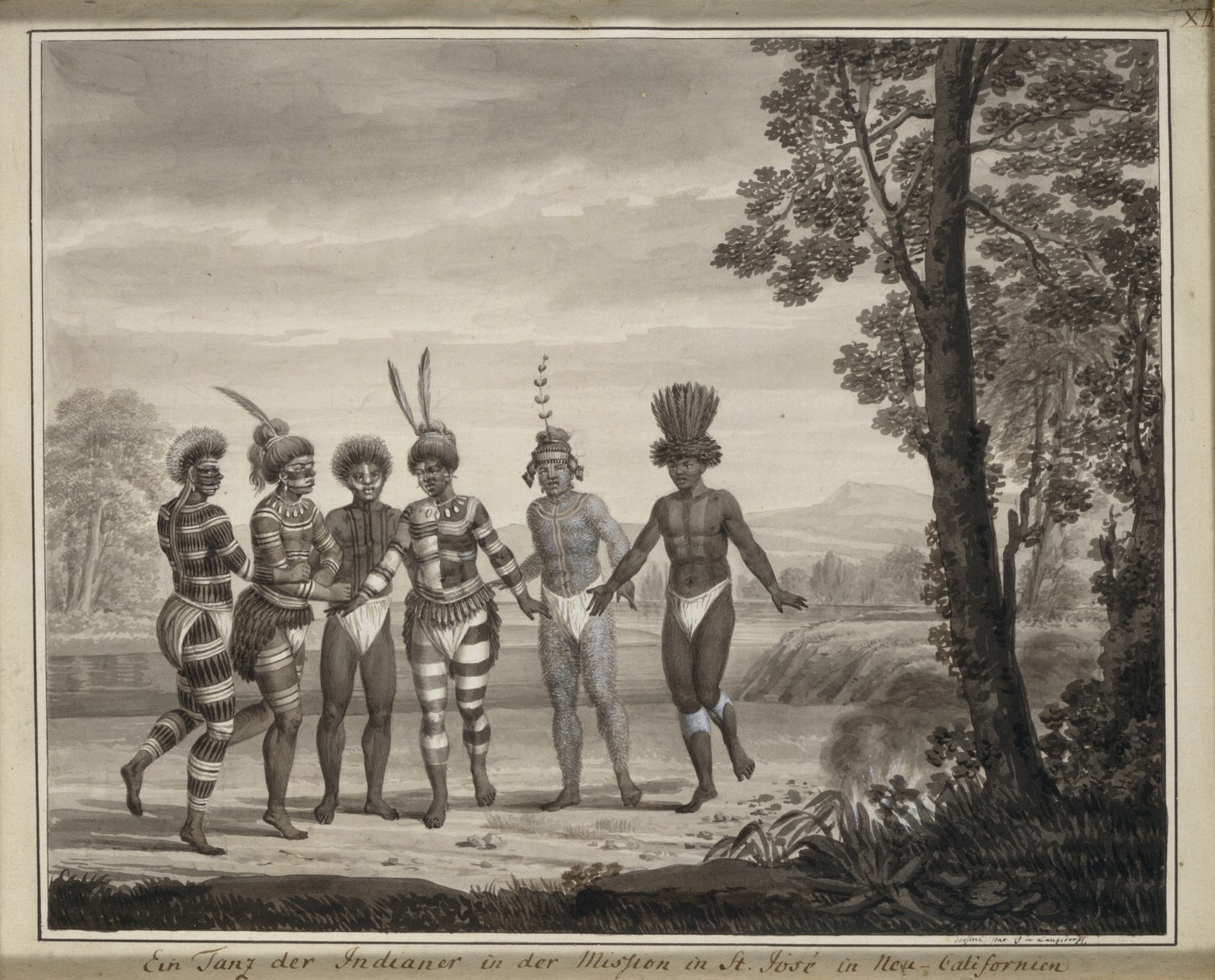|
Ohlone Languages
The Ohlone languages, also known as Costanoan, are a small family of indigenous languages spoken by the Ohlone people. The pre-contact distribution of these languages ranged from the southern San Francisco Bay Area to northern Monterey County. Along with the Miwok languages, they are members of the Utian language family. The most recent work suggests that Ohlone, Miwok, and Yokuts are branches of a Yok-Utian language family. Languages Ohlone comprises eight attested varieties: Awaswas, Chalon, Chochenyo (also spelt as Chocheño), Karkin, Mutsun, Ramaytush, Rumsen, and Tamyen. Overall, divergence among these languages seems to have been roughly equivalent to that among the languages of the Romance sub-family of Indo-European languages. Neighboring groups seem to have been able to understand and speak to each other. The number and geographic distribution of Ohlone language divisions partially mirrors the distribution of Franciscan missions in their original lands. Whil ... [...More Info...] [...Related Items...] OR: [Wikipedia] [Google] [Baidu] |
Ohlone
The Ohlone, formerly known as Costanoans (from Spanish meaning 'coast dweller'), are a Native American people of the Northern California coast. When Spanish explorers and missionaries arrived in the late 18th century, the Ohlone inhabited the area along the coast from San Francisco Bay through Monterey Bay to the lower Salinas Valley. At that time they spoke a variety of related languages. The Ohlone languages make up a sub-family of the Utian language family. Older proposals place Utian within the Penutian language phylum, while newer proposals group it as Yok-Utian. In pre-colonial times, the Ohlone lived in more than 50 distinct landholding groups, and did not view themselves as a single unified group. They lived by hunting, fishing, and gathering, in the typical ethnographic California pattern. The members of these various bands interacted freely with one another. The Ohlone people practiced the Kuksu religion. Prior to the Gold Rush, the northern California re ... [...More Info...] [...Related Items...] OR: [Wikipedia] [Google] [Baidu] |
Rumsen Language
The Rumsen language (also known as Rumsien, ''San Carlos Costanoan'' and ''Carmeleno'') is one of eight Ohlone languages, historically spoken by the Rumsen people of Northern California. The Rumsen language was spoken from the Pajaro River to Point Sur, and on the lower courses of the Pajaro, as well as on the Salinas and Carmel Rivers, and the region of the present-day cities of Salinas, Monterey and Carmel. History One of eight languages within the Ohlone branch of the Utian family, it became one of two important native languages spoken at the Mission San Carlos Borroméo de Carmelo Mission San Carlos Borromeo del Río Carmelo, or Misión de San Carlos Borromeo de Carmelo, first built in 1797, is one of the most authentically restored Catholic mission churches in California. Located at the mouth of Carmel Valley, Californ ... founded in 1770, the other being the Esselen language. The last fluent speaker of Rumsen was Isabel Meadows, who died in 1939. The Bu ... [...More Info...] [...Related Items...] OR: [Wikipedia] [Google] [Baidu] |
Felipe Arroyo De La Cuesta
Felipe Arroyo de la Cuesta (1780–1842) was a Spanish Franciscan missionary and linguist notable for his work on native languages. Arroyo de la Cuesta was born in Cubo de Bureba, Burgos, Spain in 1780. He arrived in the Spanish territory of Alta California in 1808 and worked at the Mission San Juan Bautista in California from 1808–1833. He studied and wrote numerous works on the languages of the region including Costanoan, Mutsun, and Yokuts. In 1833, Arroyo de la Cuesta handed the work of San Juan Bautista over to Zacatean Franciscans. He then worked in a number of other Central California missions including San Luis Obispo San Luis Obispo (; Spanish for " St. Louis the Bishop", ; Chumash: ''tiłhini'') is a city and county seat of San Luis Obispo County, in the U.S. state of California. Located on the Central Coast of California, San Luis Obispo is roughly h ..., San Miguel, La Purísima, and Santa Inés. He died in Santa Inés on 20 September 1842. Referen ... [...More Info...] [...Related Items...] OR: [Wikipedia] [Google] [Baidu] |
Language
Language is a structured system of communication. The structure of a language is its grammar and the free components are its vocabulary. Languages are the primary means by which humans communicate, and may be conveyed through a variety of methods, including spoken, sign, and written language. Many languages, including the most widely-spoken ones, have writing systems that enable sounds or signs to be recorded for later reactivation. Human language is highly variable between cultures and across time. Human languages have the properties of productivity and displacement, and rely on social convention and learning. Estimates of the number of human languages in the world vary between and . Precise estimates depend on an arbitrary distinction (dichotomy) established between languages and dialects. Natural languages are spoken, signed, or both; however, any language can be encoded into secondary media using auditory, visual, or tactile stimuli – for example, writing ... [...More Info...] [...Related Items...] OR: [Wikipedia] [Google] [Baidu] |
Dialect
The term dialect (from Latin , , from the Ancient Greek word , 'discourse', from , 'through' and , 'I speak') can refer to either of two distinctly different types of linguistic phenomena: One usage refers to a variety of a language that is a characteristic of a particular group of the language's speakers. Under this definition, the dialects or varieties of a particular language are closely related and, despite their differences, are most often largely mutually intelligible, especially if close to one another on the dialect continuum. The term is applied most often to regional speech patterns, but a dialect may also be defined by other factors, such as social class or ethnicity. A dialect that is associated with a particular social class can be termed a sociolect, a dialect that is associated with a particular ethnic group can be termed an ethnolect, and a geographical/regional dialect may be termed a regiolectWolfram, Walt and Schilling, Natalie. 2016. ''American Engli ... [...More Info...] [...Related Items...] OR: [Wikipedia] [Google] [Baidu] |
Ohlone Spoken Word
The Ohlone, formerly known as Costanoans (from Spanish meaning 'coast dweller'), are a Native American people of the Northern California coast. When Spanish explorers and missionaries arrived in the late 18th century, the Ohlone inhabited the area along the coast from San Francisco Bay through Monterey Bay to the lower Salinas Valley. At that time they spoke a variety of related languages. The Ohlone languages make up a sub-family of the Utian language family. Older proposals place Utian within the Penutian language phylum, while newer proposals group it as Yok-Utian. In pre-colonial times, the Ohlone lived in more than 50 distinct landholding groups, and did not view themselves as a single unified group. They lived by hunting, fishing, and gathering, in the typical ethnographic California pattern. The members of these various bands interacted freely with one another. The Ohlone people practiced the Kuksu religion. Prior to the Gold Rush, the northern California region w ... [...More Info...] [...Related Items...] OR: [Wikipedia] [Google] [Baidu] |
Catherine Callaghan
Catherine "Cathy" Callaghan (October 31, 1931 – March 16, 2019) was Professor Emerita in the Department of Linguistics at the Ohio State University in Columbus, Ohio. She received a Ph.D. in linguistics from the University of California, Berkeley in 1963. Her doctoral dissertation was a grammar of Lake Miwok, written under the supervision of Mary Haas. She then started work on the Lake Miwok Dictionary, which was published in 1965. She was appointed Assistant Professor of Linguistics at the Ohio State University in 1965 and remained there until her retirement. She was named a Fellow of the American Association for the Advancement of Science in 1969. Throughout her career Callaghan's research focused on the Penutian languages of California, especially connections between Yokuts and Miwok The Miwok (also spelled Miwuk, Mi-Wuk, or Me-Wuk) are members of four linguistically related Native American groups indigenous to what is now Northern California, who traditionally spoke on ... [...More Info...] [...Related Items...] OR: [Wikipedia] [Google] [Baidu] |
Language Revitalization
Language revitalization, also referred to as language revival or reversing language shift, is an attempt to halt or reverse the decline of a language or to revive an extinct one. Those involved can include linguists, cultural or community groups, or governments. Some argue for a distinction between language revival (the resurrection of an extinct language with no existing native speakers) and language revitalization (the rescue of a "dying" language). There has only been one successful instance of a complete language revival, the Hebrew language, creating a new generation of native speakers without any pre-existing native speakers as a model. Languages targeted for language revitalization include those whose use and prominence is severely limited. Sometimes various tactics of language revitalization can even be used to try to revive extinct languages. Though the goals of language revitalization vary greatly from case to case, they typically involve attempting to expand the number ... [...More Info...] [...Related Items...] OR: [Wikipedia] [Google] [Baidu] |
Santa Clara Valley
The Santa Clara Valley is a geologic trough in Northern California that extends 90 miles (145 km) south–southeast from San Francisco to Hollister. The longitudinal valley is bordered on the west by the Santa Cruz Mountains and on the east by the Diablo Range; the two coastal ranges meet south of Hollister. The San Francisco Bay borders the valley to the north, and fills much of the northern third of the valley. The valley floor is an alluvial plain that formed in the graben (tectonic depression) between the San Andreas Fault to the west and the Hayward and Calaveras faults to the east. Within the valley and surrounding the bay on three sides are the urban communities of San Mateo County, Santa Clara County, and Alameda County, while the narrow southern reaches of the valley extend into rural San Benito County to Hollister. In practical terms, the central portion of the Santa Clara Valley is often considered by itself, contained entirely within Santa Clara County. Th ... [...More Info...] [...Related Items...] OR: [Wikipedia] [Google] [Baidu] |
East Bay (San Francisco Bay Area)
The East Bay is the eastern region of the San Francisco Bay Area and includes cities along the eastern shores of the San Francisco Bay and San Pablo Bay. The region has grown to include inland communities in Alameda and Contra Costa counties. With a population of roughly 2.5 million in 2010, it is the most populous subregion in the Bay Area. Oakland is the largest city in the East Bay and the third largest in the Bay Area. The city serves as a major transportation hub for the U.S. West Coast, and its port is the largest in Northern California. Increased population has led to the growth of large edge cities such as Alameda, Concord, Emeryville, Fremont, Livermore, Pleasanton, San Ramon and Walnut Creek. History and development Although initial development in the larger Bay Area focused on San Francisco, the coastal East Bay came to prominence in the middle of the nineteenth century as the part of the Bay Area most accessible by land from the east. The Transcontinental Rail ... [...More Info...] [...Related Items...] OR: [Wikipedia] [Google] [Baidu] |





.jpg)
